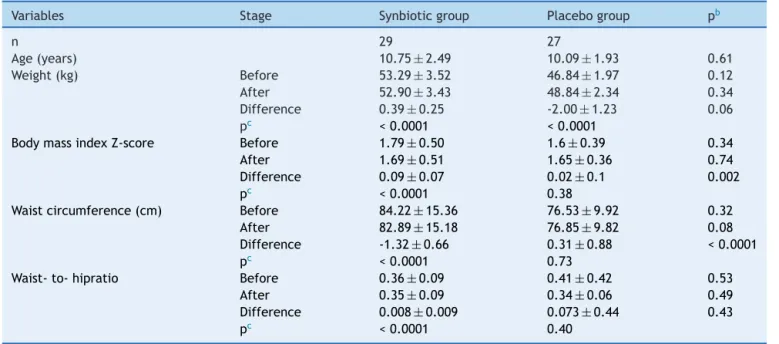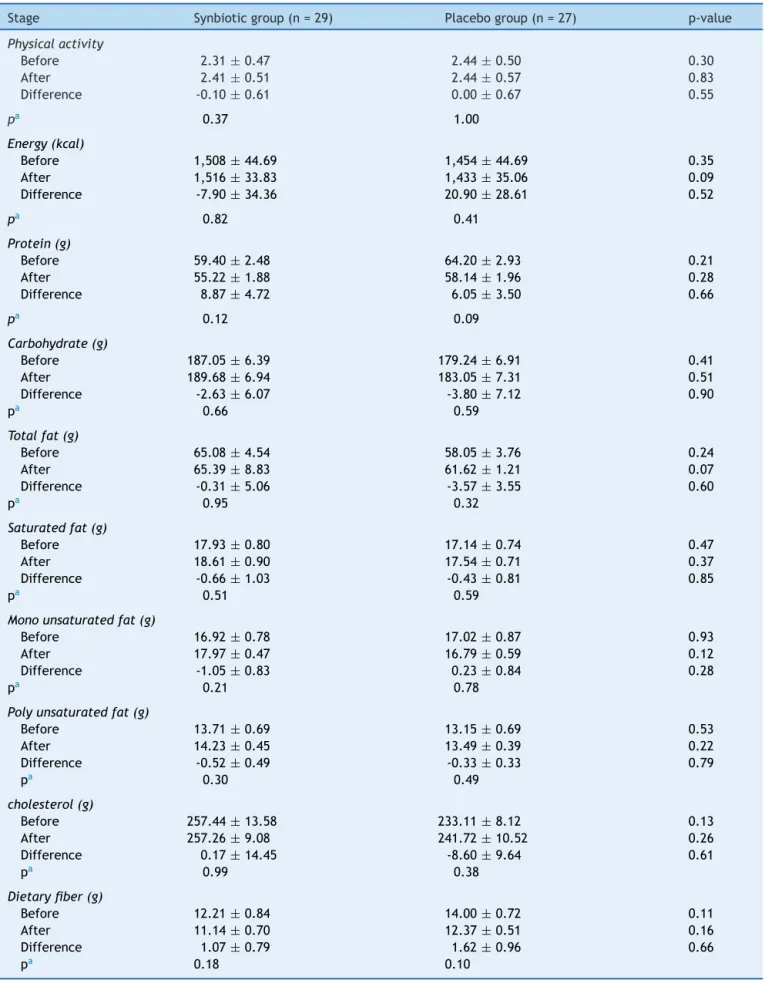www.jped.com.br
ORIGINAL
ARTICLE
A
randomized
triple-masked
controlled
trial
on
the
effects
of
synbiotics
on
inflammation
markers
in
overweight
children
夽
Roya
Kelishadi
a,b,
Sanam
Farajian
b,∗,
Morteza
Safavi
b,
Maryam
Mirlohi
a,b,
Mahin
Hashemipour
a,baDepartmentofPediatrics,ChildGrowthandDevelopmentResearchCenter,IsfahanUniversityofMedicalSciences,
Isfahan,Iran
bSchoolofNutritionandFoodSciences,IsfahanUniversityofMedicalSciences,Isfahan,Iran
Received19March2013;accepted29July2013 Availableonline30October2013
KEYWORDS
Synbiotic; Childrenand adolescents; Obesity; Inflammation; Trial
Abstract
Objective: thelowdegreeofinflammationinobesitycontributestosystemicmetabolic
dys-function.Recentexperimentalstudiesproposedsomeeffectsofalterationingutmicrobiotaon
inflammatoryfactors.Thisstudyaimedtoassesstheanti-inflammatoryeffectsofasynbiotic
supplementoninflammationmarkersinoverweightandobesechildrenandadolescents.
Methods: thisrandomizedtriple-maskedcontrolledtrialwasconductedamong70participants
aged6to18years,withabodymassindex(BMI)equalorhigherthanthe85thpercentile.They
wererandomlyassignedintotwogroupsofequalnumbertoreceivesynbioticorplacebofor
eightweeks.
Results: fifty-six of70 participants(80%) completed thestudy. Comparedwiththe placebo
group,thesynbiotic grouphadsignificantdecreaseinmeanvaluesoftumornecrosis-␣and
interleukin-6,withsignificantincreaseinadiponectin;thesechangeswerenolongersignificant
afteradjustmentforBMI.Therewasnosignificantchangeinthemeanvaluesofhigh-sensitive
C-reactiveprotein.
Conclusion: thepresentfindingssuggestthepositiveinfluenceofsynbioticsupplementationon
inflammationfactors,whicharedependenttoitseffectonweightreductioninoverweightand
obesechildren.
©2013SociedadeBrasileiradePediatria.PublishedbyElsevierEditoraLtda.Allrightsreserved.
夽 Pleasecitethisarticleas:KelishadiR,FarajianS,SafaviM,MirlohiM,HashemipourM.Arandomizedtriple-maskedcontrolledtrialon
theeffectsofsynbioticsoninflammationmarkersinoverweightchildren.JPediatr(RioJ).2014;90:161---8. ∗Correspondingauthor.
E-mail:farajian.sanam@gmail.com(S.Farajian).
PALAVRAS-CHAVE
Simbiótico; Crianc¸ase adolescentes; Obesidade; Inflamac¸ão; Ensaioclínico
Ensaioclínicocontroladorandomizadotriplo-cegodosefeitosdesimbióticossobre marcadoresdeinflamac¸ãoemcrianc¸ascomsobrepeso
Resumo
Objetivo: o baixo grau de inflamac¸ão na obesidade contribui para disfunc¸ão metabólica
sistêmica.Estudosexperimentaisrecentespropuseramalgunsefeitosdealterac¸ãona
micro-biota intestinal sobre fatores inflamatórios. O objetivo deste estudo foi avaliar os efeitos
anti-inflamatóriosdeumsuplementosimbióticosobremarcadoresdeinflamac¸ãoemcrianc¸as
eadolescentescomsobrepesoeobesos.
Métodos: esteensaioclínicocontroladorandomizadotriplo-cegofoiconduzidoentre70
partic-ipantescomidadeentreseise18anos,comíndicedemassacorporal(IMC)igualouacimado85◦
percentil.Elesforamaleatoriamentedivididosemdoisgruposdeigualnúmerodeparticipantes
pararecebersimbióticoouplaceboporoitosemanas.
Resultados: notodo, 56 de70 participantes(80%) concluíramoestudo.Emcomparac¸ão ao
grupoplacebo, ogruposimbióticoteve reduc¸ãosignificativanos valoresmédios denecrose
tumoral-␣einterleucina-6,comaumentosignificativonaadiponectina;essasalterac¸õesnão
erammaisexpressivasapósoajustedoIMC.Nãohouvealterac¸ãoimportantenosvaloresmédios
daproteínaC-reativaaltamentesensível.
Conclusão: nossasconclusõessugeremainfluênciapositivadasuplementac¸ãosimbióticasobre
fatores inflamatórios, dependentede seuefeito sobrea reduc¸ãode pesoem crianc¸ascom
sobrepesoeobesas.
©2013SociedadeBrasileiradePediatria.PublicadoporElsevierEditoraLtda.Todososdireitos
reservados.
Introduction
Theemergingglobalepidemicofobesityisaserioushealth problem at individual and public health levels. This is of special concern for the pediatric age group. Obesity is associatedwithchroniclow-gradeinflammation,which con-tributes to the systemic metabolic dysfunction linked to obesity-linkeddisorders,suchasmetabolicsyndrome.1
Increased expression and production of cytokines and acute phase reactants such as C-reactive protein (CRP), interleukins (ILs), tumor necrosis factor ␣ (TNF- ␣), or
lipopolysaccharides(LPS)resultinthelowdegreeof inflam-mationamongobeseindividuals.2,3
Somestudies proposedthatgut microbiotamay partic-ipate in the whole-body metabolism by affecting energy balance,glucosemetabolism, andlow-gradeinflammation associatedwithobesityandrelatedmetabolicdisorders.4
Itisdocumentedthatgutmicrobiotaaredifferentamong obeseandeutrophicindividuals.5,6Gutmicrobiota-derived
LPSareknown asa factor involved in theonset and pro-gressionofinflammationandmetabolicdisorders.7LPSare
acomponent of Gram-negative bacteria cell walls, which are among the most potent and well-studied inducers of inflammation.4
Moreover,anychangeinthegutmicrobiotamayleadto changein theproductionof endotoxinandthuschange in theLPSlevels.7,8
Althoughthe intestinalepitheliumactsasacontinuous barrier toavoid LPStranslocation, some events can dam-age this barrier.For instance, a study demonstrated that the modulation of gut bacteria following a high-fat diet stronglyincreasedthe intestinalpermeability byreducing theexpressionofgenescoding.9
Therefore,itcanbeassumedthatregulatinggut micro-biotamaybeanappropriatestrategytocontrolobesityand itsrelateddisorders.
Therefore, it was hypothesized that supplementation withsynbiotics,whichmodulatesgut microbiotaandtheir production,maybeeffectiveinchangingmarkersof inflam-mationinindividualswithexcessweight.Thisstudyaimed to investigate the effectof synbioticsupplementation on inflammatoryfactorsinoverweightandobesechildrenand adolescents.
Method
The detailed methods of this study have been previously published;10thefindingsonmarkersofinflammation,which
have not been reported before, are presented here. The studywasconductedfromSeptembertoNovemberof2011 attheIsfahanUniversityofMedicalSciences(IUMS),Isfahan, Iran.Itwasarandomizedtriple-blindedcontrolledtrial,i.e. theresearchers,participantsandstatisticianweremasked tothegroupsunderstudy.
ThetrialprotocolwasinaccordancewiththeDeclaration of Helsinki,and wasapprovedbythe ResearchandEthics CommitteeofIUMS.Thetrialwasregisteredundertrial reg-istrycodeIRCT201103081434N4atthenationalregistryfor clinicaltrials,whichisamemberoftheWorldHealth Orga-nization.
Afterprovidingdetailed information, an informed con-sentwassignedbyparents,andoralassentfromparticipants wasobtained.
Participants
70apparentlyhealthychildrenandadolescents,aged6to 18years,withabodymassindex(BMI)equal toor higher thantheage-andgender-specific85threvised percentiles oftheCentersforDiseaseControlandPrevention,11 which
fromchildren whowere referredto thePediatricObesity and Metabolic Syndrome Clinic of the Child Growth and DevelopmentResearchCenteroftheIUMS.Participantswere randomizedtoeithersynbiotic(n=35)orplacebo(n=35) groups throughrandomtable numbers.Childrenwith syn-dromalobesity,endocrinedisorders,anyphysicaldisability, history of chronic medication use, use of mineral and/or vitaminsupplements,historyofanychronicdiseasesand/or chronicmedication use,or thoseunderspecialdiets were notincludedinthestudy.Thetrialdurationwaseightweeks, and both groups received similar counseling for lifestyle modificationregardingdietaryandphysicalactivityhabits.
Physicalexamination
The participants’ age and birth date were recorded. All anthropometric measurements were made by the same trainedpersonandunderthesupervisionofthesame pedia-trician.Physicalexaminationwasconductedunderstandard protocolsthroughcalibrated instruments at the beginning andendofthetrial.
Bodyweightwasmeasuredwithadigitalfloorscale(Seca -Hamburg,Germany)with100gaccuracy,withoutshoesand withminimum clothing. Height wasmeasured, with1mm accuracy,withanon-stretchtape.
Waistandhipcircumferencesweremeasuredwitha non-elastictape.Waistcircumferencewasmeasuredatapoint midwaybetweenthelowerborderoftheribcageandthe iliaccrestat theendofnormalexpiration.Hip circumfer-encewasmeasuredatthemaximumgirthofthebuttocks, andwaist-to-hipratiowascalculated.
Biochemicalmeasurements
Participantswereinstructedtofastfor12hoursbeforeblood sampling. With one of the parents accompanying his/her child,bloodsamplesweretakenfromtheantecubitalvein between 08:00and09:30 am. Aftercollectingblood sam-ples,theparticipantswereservedahealthysnackprovided bytheprojectteam.CRP,TNF-␣,IL-6,andadiponectinwere
measured enzymatically with standard auto-analyzer kits (ParsAzmoun,Iran).
Synbioticadministration
Synbiotic capsules (Protexin - London, England) were used, each containing 2.0 × 108 colony-forming units
(CFU)/day. They contained a combination of viable frozen-dried)Lactobacilluscasei, Lactobacillusrhamnosus, Streptococcusthermophilus,Bifidobacteriumbreve, Lacto-bacillusacidophilus,Bifidobacteriumlongum,Lactobacillus bulgaricus)ofhumanoriginwithprebiotics(frocto oligosac-charides),vitaminE,vitaminA,andvitaminC.Thechildren and adolescents assigned to the synbiotic group were instructed totake onecapsule a day beforea main meal foreightweeks.
TheplacebowaspreparedinthePharmaceutics Depart-mentoftheFacultyofPharmacyoftheIUMS.Itcontained maltodextrineandconsistedofcapsuleswithshape,taste, andsmellidenticaltothesynbioticcapsules.
Inadditiontoregularvisits of participants,medication adherencewastrackedbystoolsample collectionandthe countofbacteriainstool,aswellasbyweeklyphonecall toparticipants.
Stoolsamplecollection
Stool samples were collected from both synbiotic and placebo groups at baseline and onthe days15 and 60 of thetrial. Sampleswerekeptrefrigeratedinsealedplastic fecescontainersforlessthansixhoursuntiltheywere trans-ferredtothelaboratory,wheretheywereexaminedatthe earliestpossibletime.
Media
MRSagar(Merck-Germany,pH=5.7)andMRSagar(Merck -Germany, pH = 5.7) combined with1% muprocin (Sigma - United States) and 0.5% systein hydrochloride (Sigma -UnitedStates)wereusedforenumerationofLactobacillus
andBifidobacteriumcolonies,respectively.
Bacterialcounts
Eachfecalsample(0.5g)wasplacedinthesterilizedtube combinedwith5mLof sterile normal saline, mixed thor-oughly,andcentrifugedfor5minutesat100rpm.1mLofthe upperphasewasseriallytenfold-dilutedtoa10−7dilution.
100L of the proper dilution was surface-cultured on
bothtypes of plates.Plateswereincubatedanaerobically with 5% CO2, using a CO2-injected incubator. MRS plates
werekeptat37◦ to38◦Cfor48hours,andtheplates
con-tainingMRS-muprocin-hydrochloridewerekeptatthesame temperaturefor72hours.
Colony counting was performed by an expert and expressedasalogoftheCFUpergramoffreshfeces.
Dietaryrecords
Nutrient intakes were estimated using three-day dietary record(twoweekdaysandoneweekendday)atthe begin-ningandat the endof thestudy.Participants wereasked towrite down thetype and amount of food eaten, using scalesorhouseholdmeasurestogaugeportionsizeswhere possible.Three-dayaveragesofenergyandmacronutrient intakeswereanalyzedusingtheNutritionist4software(First DatabankInc.,HearstCorp.-SanBruno,CA,UnitedStates). Dataentrywasperformedbyatraineddietitian.Ifa partic-ipantateafoodnotincludedinthedatabase,anotherfood withverysimilarnutrientcompositionwasselected. Nutri-entinformation wasalso obtained through foodlabels or recipesfromparticipants.Participantswereencouragedto keeptheirdietaryintakesandexercisepatternsmonitored by the Physical Activity Questionnaire for Older Children (PAQ-C)unchangedduringtheexperiment.
Statisticalanalysis
Table1 Anthropometricmeasuresaofparticipantsbeforeandafterthetrial.
Variables Stage Synbioticgroup Placebogroup pb
n 29 27
Age(years) 10.75±2.49 10.09±1.93 0.61
Weight(kg) Before 53.29±3.52 46.84±1.97 0.12
After 52.90±3.43 48.84±2.34 0.34
Difference 0.39±0.25 -2.00±1.23 0.06
pc <0.0001 <0.0001
BodymassindexZ-score Before 1.79±0.50 1.6±0.39 0.34
After 1.69±0.51 1.65±0.36 0.74
Difference 0.09±0.07 0.02±0.1 0.002
pc <0.0001 0.38
Waistcircumference(cm) Before 84.22±15.36 76.53±9.92 0.32
After 82.89±15.18 76.85±9.82 0.08
Difference -1.32±0.66 0.31±0.88 <0.0001
pc <0.0001 0.73
Waist-to-hipratio Before 0.36±0.09 0.41±0.42 0.53
After 0.35±0.09 0.34±0.06 0.49
Difference 0.008±0.009 0.073±0.44 0.43
pc <0.0001 0.40
aValuesarepresentedasmean
±standarddeviation.
b p-value resulted from Student’s t-test for independent variables for difference between probiotic and placebo groups after intervention
c p-valueresultedfrompairedStudent’st-testfordifferencewithingroupsthroughoutthestudy.
usedforstatisticalanalysis.Descriptivedatawereexpressed asmean±standarddeviation(SD).Afterassessmentofthe normaldistributionbytheKolmogorov-Smirnovtest, intra-group changes were compared by the paired Student’s
t-test, andStudent’s t-testfor independentvariables was usedfor inter-group comparison. Data of overweight and obese participants were also compared. Paired Student’s
t-test wasalsousedforcomparingbefore-and-after inter-vention within each group. Ptime, Pgroup and Ptime × group
were measured for each variable through analysis of the covariance(ANCOVA).Totalfecalbacterialcountsofthetwo groupsstudiedwerecomparedatbaseline,andontheday15 and60ofthetrial.p-valueslowerthan0.05wereconsidered asstatisticallysignificant.
Results
Overall,56outof70participants(80%)completedthestudy; therestdidnothavecompleteadherence.Theparticipants who completed the trial demonstrated good compliance withthesupplement consumption,andnoadverseeffects orsymptomswerereported.
Physicalcharacteristics
Thedemographicsandphysicalcharacteristicsatthe begin-ningofthestudydidnotdiffersignificantlybetweenthetwo groups.Table1presentsthecomparisonsof anthropomet-ricmeasuresbetweenthesynbioticandplacebogroups,as wellasintra-groupdifferences beforeandafterthe trial. The BMI Z-score decreased significantly in the synbiotic group(1.79±0.09vs.1.69±0.09,respectively,p<0.0001), whereasthecorrespondingfigurewasnotsignificantinthe
placebo group(1.67±0.07 vs.1.65±0.07,respectively, p =0.38).Likewise,thechangeinthemeanwaist circumfer-encewassignificantinthesynbioticgroup(84.22±2.85vs. 82.89±2.82cm,respectively, p <0.0001), butnot signifi-cantintheplacebogroup(76.53±1.91vs.76.85±1.92cm, respectively,p=0.73)
Dietaryintakeandphysicalactivitylevelof participants
Theenergyandnutrientintake,aswellasthelevelsof phys-icalactivity, were notsignificantly different between the twogroups,anddidnotchangesignificantlyduringthestudy (Table2).
Laboratoryfindings
As presented in Table 3, during the experimental period, thefecaltotalcountsincreasedsignificantlyinthesynbiotic groupcomparedtotheplacebogroup.9
Themean(SE)ofinflammationfactorsbeforeandafter receivingsynbioticsupplementandplaceboarepresentedin
Table4.Comparedwiththeplacebogroup,thesupplement group presenteda significant decreasein TNF-␣,IL-6
lev-els,andasignificantincreaseinadiponectin;thesechanges werenolongersignificantafteradjustmentforBMI.There wasnosignificantchangeinhigh-sensitivityC-reactive pro-tein(hs-CRP)level.
Discussion
Table2 Dietaryintakeandphysicalactivitylevelofparticipantsthroughoutthetrial.
Stage Synbioticgroup(n=29) Placebogroup(n=27) p-value
Physicalactivity
Before 2.31±0.47 2.44±0.50 0.30
After 2.41±0.51 2.44±0.57 0.83
Difference -0.10±0.61 0.00±0.67 0.55
pa 0.37 1.00
Energy(kcal)
Before 1,508±44.69 1,454±44.69 0.35
After 1,516±33.83 1,433±35.06 0.09
Difference -7.90±34.36 20.90±28.61 0.52
pa 0.82 0.41
Protein(g)
Before 59.40±2.48 64.20±2.93 0.21
After 55.22±1.88 58.14±1.96 0.28
Difference 8.87±4.72 6.05±3.50 0.66
pa 0.12 0.09
Carbohydrate(g)
Before 187.05±6.39 179.24±6.91 0.41
After 189.68±6.94 183.05±7.31 0.51
Difference -2.63±6.07 -3.80±7.12 0.90
pa 0.66 0.59
Totalfat(g)
Before 65.08±4.54 58.05±3.76 0.24
After 65.39±8.83 61.62±1.21 0.07
Difference -0.31±5.06 -3.57±3.55 0.60
pa 0.95 0.32
Saturatedfat(g)
Before 17.93±0.80 17.14±0.74 0.47
After 18.61±0.90 17.54±0.71 0.37
Difference -0.66±1.03 -0.43±0.81 0.85
pa 0.51 0.59
Monounsaturatedfat(g)
Before 16.92±0.78 17.02±0.87 0.93
After 17.97±0.47 16.79±0.59 0.12
Difference -1.05±0.83 0.23±0.84 0.28
pa 0.21 0.78
Polyunsaturatedfat(g)
Before 13.71±0.69 13.15±0.69 0.53
After 14.23±0.45 13.49±0.39 0.22
Difference -0.52±0.49 -0.33±0.33 0.79
pa 0.30 0.49
cholesterol(g)
Before 257.44±13.58 233.11±8.12 0.13
After 257.26±9.08 241.72±10.52 0.26
Difference 0.17±14.45 -8.60±9.64 0.61
pa 0.99 0.38
Dietaryfiber(g)
Before 12.21±0.84 14.00±0.72 0.11
After 11.14±0.70 12.37±0.51 0.16
Difference 1.07±0.79 1.62±0.96 0.66
pa 0.18 0.10
Dataarepresentedasmeans±standarderror(SE)fornutrient. Dataarepresentedasmeans±standarddeviationforphysicalactivity.
Table3 Bacterialcountinstoolatthreetimesduringthetrial.
TypeofBacteria Stage SynbioticgroupMean±SD PlacebogroupMean±SD
GenusLactobacillus Baseline 46990603±68305170 35554312±52377526
Day15 9.8849404±56632828 20521047±14446100
Day60 104007006±95400927 28320225±28512981
p-value 0.029 0.69
Bifidobacteria Baseline 483104.1±1083977.2 1856453.3±5486345.3
Day15 92521.0±117058.9 35964.9±26621.0
Day60 1965978.9±2699014.4 337154.7±610843.9
p-value 0.06 0.39
SD,standarddeviation.
effectof synbiotic supplementation oninflammatory fac-torsin overweight andobese children andadolescents.It was observed that the intake of synbiotic had favorable results in weightreduction of obese children and adoles-cents,aswellasinsignificantchangesofserumTNF␣,IL-6,
andadiponectin,withoutchangeinthehs-CRPlevel. How-ever,thechangesininflammationmarkersweredependent onweightreduction.
Duringthestudyperiod,theenergy,macronutrient,and also antioxidant intake, and the level of physical activi-tiesdidsignificantlychange withineach group,besidesan increaseinconcentrationsofprotectivebacteria,asshown
bythemicrobiologicaldata,andtheirmetabolicactivities suggestthattheobtainedresultsmaybeduetothesynbiotic supplementation.
Canietal.recentlydemonstratedthatmicefedahigh-fat diet were characterizedby an increase in gut permeabil-ity and metabolic endotoxaemia or LPS,10 which consists
in leakage intothe body from the Gram-negative part of the intestinal microbiota, and its factors are involved in the onset and progressionof inflammation and metabolic diseases.4 Thus, probioticsmay be effective in improving
thegut-barrierand suppressingGram-negativebacteria in thegastrointestinalchannel.13,14 Itwasdemonstratedthat
Table4 Effectsofsynbioticandplaceboconsumptiononinflammationmarkers.
Variables Stage Synbioticgroup
n=28
mean±SE
Placebogroup
n=27
mean±SE
pa Time×groupb Timec Groupd
Hs-CRP Before 2.05±0.92 1.66±0.96 0.42 0.61 0.141 0.92
After 1.03±0.14 1.75±0.13 0.17
Difference -0.7±0.07 0.09±0.05 0.06
pe 0.02 0.75
TNF␣ Before 123.14±9.63 94.15±9.44 0.06 0.008 0.92 0.152
After 113.25±3.30 103.40±3.26 0.48
Difference -9.89±0.55 9.25±0.68 p<0.0001
pe 0.02 0.10
Adjustedf 1.02±0.08 1.14±0.09 0.105
IL-6 Before 130.07±4.73 121.30±4.50 0.37 0.118 0.06 0.72
After 119.25±3.62 120.33±4.66 0.92
Difference -10.82±0.64 -0.96±0.82 P<0.0001
pe 0.04 0.76
Adjustedf 1.13±0.05 1.26±0.06 0.06
Adiponectin Before 261.61±3.96 283.67±3.17 0.34 0.05 0.139 0.82
After 289.64±11.59 279.07±11.83 0.70
Difference 28.03±1.39 -3.69±1.97 p<0.0001
pe P<0.0001 0.79
Adjustedf 2.94±0.90 2.74±0.14 0.25
Hs-CRP,highsensitivityC-reactiveprotein;IL-6,Interleukin6;TNF␣,tumornecrosisfactor␣. Allvaluesareexpressedasmean±standarderror(SE).
ap-valuespresentthecomparisonofbaseline(computedbyStudent’st-testforindependentsamples)andend-pointvaluesbetween twogroups(computedbyanalysisofthecovariance[ANCOVA]).
b p-valuesrepresentthetimexgroupinteraction(computedbyANCOVA). c p-valuesdemonstratetheeffectoftime(computedbyANCOVA). d p-valuesrepresenttheeffectofgrouping(computedbyANCOVA).
probioticsstrainssuchasLactobacillus rhamnosusGG and
LactobacilluscaseiDN-114---001 protecttheepithelial bar-rierfunctionagainstEscherichiacoli-inducedredistribution ofthetight-junctionproteins,15,16 andthatsomeprobiotic
strains,suchasL.plantarum299v,canmitigatebacterial translocation.17,18
High-fatdietcontributestothedisruptionofthe tight-junction proteins (zonula occludens-1 Z◦−1 and occludin)
involvedinthegutbarrierfunction,10,19andmodulationof
gutmicrobiotaofmicewithprebiotic wouldleadtolower levelsof several plasma cytokines,such asTNF-␣ and
IL-6, due topromotion of tight-junction proteins (ZO-1 and occludin) disruption. These data confirm that obese mice exhibitanalteredgutbarrier,characterizedbyadisruption of tight-junction proteins. Cani etal. concluded that the modulationofthegutmicrobiotausingprebioticsinobese micecouldactfavorably ontheintestinalbarrier,thereby reducing endotoxaemia and systemic and liver inflamma-tion,withbeneficialconsequencesonassociatedmetabolic disorders.19,20
Furthermore, it has been demonstrated in healthy humansthatL.plantarumWCSF1increasedtherelocation ofoccludinandZO-1 intothetightjunctionareabetween duodenalepithelialcells.21
The presentsfindings areconsistent withthoseon the connection between gut microbiota, inflammation, and homeostasis,andtheirrolein thepathogenesisofobesity and relateddisorders,19,22 aswell as withthe findings on
therelationshipofdietandgutmicrobiotawith homeosta-sis,asinvestigatedinexperimentalmodelsofdiet-induced obesity.23,24 It appears that, because of the association
between obesity and inflammation,25 it can be proposed
that the favorable effects of probiotics in controlling inflammation may play a role in obesity prevention and control.
Among the probable mechanisms, it has been demon-stratedthatthemodulationofthegutmicrobiotaincreases villus height and crypt depth, and leads to a thicker mucosal layer in the jejunum and in the colon.26
These effects are due to fermentation products of bac-teria, mainly short-chain fatty acids (SCFAs), such as butyrate, which acts as an energetic substrate for the colonocytes and have a trophic effect on mucosa.27,28
In the present study, this mechanism was highlighted, because an increase in the concentrations of protective bacteria due to the synbiotic supplementation was docu-mented.
Plasma adipocytokine levels rise with an increase in adipose tissue and adipocyte volume, except for plasma adiponectin, which is lower in obesity.29,30 In the present
study,theincreaseinplasmaadiponectinwasduetoweight reductionandsuppressionoffattissue.
In conclusion,the present findingssuggest the positive influenceofsynbioticsupplementationoninflammation fac-tors,whosechangesaredependentonweightreductionin overweightandobesechildren.
Funding
Thistrial wasconductedasathesisfundedbytheIsfahan UniversityofMedicalSciences,Isfahan,Iran
Conflicts
of
Interest
Theauthorsdeclarenoconflictsofinterest.
Acknowledgements
ThisstudywasfundedbyViceChancelleryforResearchand Technology,IsfahanUniversityofMedicalSciences,Isfahan, Iran.Guarantor:Prof.RoyaKelishadi
References
1.Scarpellini E, Tack J. Obesity and metabolic syndrome: an inflammatorycondition.DigDis.2012;30:148---53.
2.Hotamisligil GS. Endoplasmicreticulumstress and inflamma-tion in obesity and type 2 diabetes. Novartis Found Symp. 2007;286:86---94.
3.HotamisligilGS,ErbayE.Nutrientsensingandinflammationin metabolicdiseases.NatRevImmunol.2008;8:923---34. 4.CaniPD,OstoM,GeurtsL,EverardA.Involvementofgut
micro-biotainthedevelopmentoflow-gradeinflammationandtype2 diabetesassociatedwithobesity.GutMicrobes.2012;3:279---88. 5.BäckhedF,ManchesterJK,SemenkovichCF,GordonJI. Mech-anisms underlying the resistance to diet-induced obesity in germ-freemice.ProcNatlAcadSciUSA.2007;104:979---84. 6.LeyRE,BäckhedF,TurnbaughP,LozuponeCA,KnightRD,Gordon
JI.Obesityaltersgutmicrobialecology.ProcNatlAcadSciUSA. 2005;102:11070---5.
7.BäckhedF,DingH,WangT,HooperLV,KohGY,NagyA,etal. Thegutmicrobiotaasanenvironmentalfactorthatregulates fatstorage.ProcNatlAcadSciUSA.2004;101:15718---23. 8.CaniPD,AmarJ,IglesiasMA,PoggiM,KnaufC,BastelicaD,etal.
Metabolicendotoxemiainitiatesobesityandinsulinresistance. Diabetes.2007;56:1761---72.
9.CaniPD,BibiloniR,KnaufC,WagetA,NeyrinckAM,Delzenne NM, et al. Changes in gut microbiota control metabolic endotoxemia-induced inflammation in high-fat diet-induced obesityanddiabetesinmice.Diabetes.2008;57:1470---81. 10.Safavi M, Farajian S, Kelishadi R, Mirlohi M, Hashemipour
M.Theeffectsofsynbioticsupplementationonsome cardio-metabolic risk factors in overweight and obese children: a randomizedtriple-maskedcontrolledtrial.IntJFoodSciNutr. 2013;64:687---93.
11.KuczmarskiRJ,OgdenCL,GuoSS,Grummer-StrawnLM, Fle-gal KM, Mei Z, et al. 2000 CDC growth charts for the UnitedStates:methodsanddevelopment.VitalHealthStat11. 2002;246:1---190.
12.KelishadiR,ArdalanG,GheiratmandR,MajdzadehR,Hosseini M, Gouya MM, et al. Thinness,overweight and obesity in a nationalsampleofIranianchildrenandadolescents:CASPIAN Study.ChildCareHealthDev.2008;34:44---54.
13.StrowskiMZ, WiedenmannB. Probioticcarbohydratesreduce intestinalpermeabilityandinflammationinmetabolicdiseases. Gut.2009;58:1044---5.
14.FrazierTH,DiBaiseJK,McClainCJ.Gutmicrobiota,intestinal permeability, obesity-induced inflammation,and liver injury. JPENJParenterEnteralNutr.2011;35:14S---20S.
15.Johnson-Henry KC, Donato KA, Shen-Tu G, Gordanpour M, Sherman PM. Lactobacillus rhamnosus strain GG prevents enterohemorrhagicEscherichiacoli O157:H7-inducedchanges inepithelialbarrierfunction.InfectImmun.2008;76:1340---8. 16.ParassolN,FreitasM,ThoreuxK,DalmassoG,Bourdet-SicardR,
17.McNaughtCE,WoodcockNP,AndersonAD,MacFieJ.A prospec-tiverandomisedtrialofprobioticsincriticallyillpatients.Clin Nutr.2005;24:211---9.
18.KlarinB,WulltM,PalmquistI,MolinG,LarssonA,JeppssonB.
Lactobacillusplantarum299vreducescolonisationof Clostrid-iumdifficileincriticallyill patientstreatedwithantibiotics. ActaAnaesthesiolScand.2008;52:1096---102.
19.Cani PD, Possemiers S, Vande WieleT, Guiot Y, Everard A, RottierO,etal.Changesingutmicrobiotacontrol inflamma-tioninobesemicethroughamechanisminvolvingGLP-2-driven improvementofgutpermeability.Gut.2009;58:1091---103. 20.Delzenne NM, NeyrinckAM, Cani PD. Modulation of the gut
microbiota by nutrients with prebiotic properties: conse-quencesforhosthealthinthecontextofobesityandmetabolic syndrome.MicrobCellFact.2011;10:S10.
21.HakanssonA,MolinG.Gutmicrobiotaandinflammation. Nutri-ents.2011;3:637---82.
22.Tsukumo DM, Carvalho-Filho MA, Carvalheira JB, Prada PO, HirabaraSM,SchenkaAA, etal.Loss-of-function mutationin Toll-likereceptor4prevents diet-inducedobesityandinsulin resistance.Diabetes.2007;56:1986---98.
23.Hong YH, Nishimura Y, Hishikawa D, Tsuzuki H, Miyahara H, Gotoh C, et al. Acetate and propionate short chain fattyacidsstimulateadipogenesisviaGPCR43.Endocrinology. 2005;146:5092---9.
24.Cani PD, Delzenne NM. The role of the gut microbiota in energy metabolism and metabolic disease. Curr Pharm Des. 2009;15:1546---58.
25.ItemF,KonradD.Visceralfatandmetabolicinflammation:the portaltheoryrevisited.ObesRev.2012;13:30---9.
26.KleessenB,HartmannL, BlautM.Fructansinthediet cause alterationsofintestinalmucosalarchitecture,releasedmucins andmucosa-associatedbifidobacteriaingnotobioticrats.BrJ Nutr.2003;89:597---606.
27.BartholomeAL,AlbinDM,BakerDH,HolstJJ,TappendenKA. Supplementation of totalparenteral nutrition with butyrate acutely increases structural aspects of intestinal adaptation afteran80%jejunoilealresectioninneonatalpiglets.JPENJ ParenterEnteralNutr.2004;28:210---22.
28.Tappenden KA, Drozdowski LA, Thomson AB, McBurney MI. Short-chainfattyacid-supplementedtotalparenteralnutrition altersintestinalstructure,glucosetransporter2(GLUT2)mRNA andprotein,andproglucagonmRNAabundanceinnormalrats. AmJClinNutr.1998;68:118---25.
29.Reinhardt C, Reigstad CS, Bäckhed F. Intestinal microbiota duringinfancyanditsimplicationsfor obesity.JPediatr Gas-troenterolNutr.2009;48:249---56.


